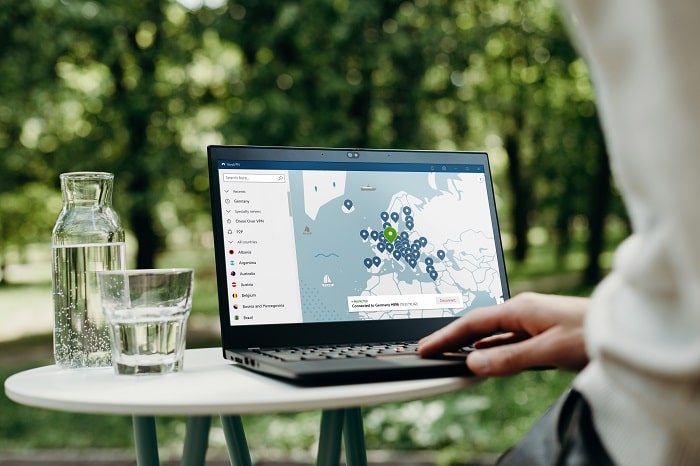Here’s the thing: dropshipping in 2025 isn’t quite the same as it was a few years ago. Customers are savvier, competition is higher, and search engines expect better websites. That means if you want to set up a successful dropshipping business this year, you’ll need to approach it strategically – with the right niche, reliable suppliers, strong hosting, and smart marketing.
Before diving into all the steps, let’s quickly break down the basics so you know exactly what you’re getting into.
Read next: How to Create an eCommerce Website: Step-by-Step Guide for Beginners
- Start with a strong foundation: Choose a solid hosting provider like DreamHost for WooCommerce for a reliable, scalable store and get a free domain name when you sign up for annual plans.
- Pick your niche wisely: Focus on evergreen, in-demand products with healthy margins. Use tools like KWFinder to uncover profitable keyword opportunities before you launch.
- Partner with trustworthy suppliers: Check product quality, delivery times, and reviews before adding them to your catalog. Building long-term supplier relationships means fewer headaches later.
- Design and branding matter: Use WooCommerce-optimized themes like Divi or Ashe PRO to give your store a clean, fast, and SEO-friendly look that customers trust.
- Marketing is everything: Combine SEO, blogging (included with DreamHost’s managed WooCommerce plan), and social media to attract consistent traffic without relying only on ads.
- Offer a professional experience: Set up a branded email (included for free with DreamHost for WooCommerce hosting) and create essential store pages like About, Contact, and Return Policy to boost trust.
- Consistency = success: Dropshipping takes time — test, tweak, and stay focused. The stores that thrive are the ones that treat it like a real business, not a get-rich-quick scheme.
What Is Dropshipping?

Dropshipping has been one of the most searched business models in recent years.
Why?
Because it’s flexible, it doesn’t require you to buy stock upfront, and can be started with a relatively small investment.
In short, dropshipping is an e-commerce fulfillment model where you, the store owner, don’t actually stock the products you sell. Instead, you act as the middle person between the customer and the supplier.
Here’s how it works in practice:
- A customer places an order on your online store.
- You forward the order to your supplier (this process can be automated).
- The supplier packages and ships the product directly to your customer.
Similar to owning a print-on-demand clothing business, you never touch the inventory, which is why this model is often seen as a low-risk way to start a business online.
One of the biggest appeals is that you don’t need a warehouse or a big upfront investment to begin. All you need is:
- A domain name
- A hosting plan for WooCommerce
- A good WordPress theme, like Ashe PRO, so that your store has a professional look
- Reliable suppliers
- Smart marketing strategies
✅ Pro tip: If you’re just starting out, dropshipping is also a great way to learn digital marketing without spending thousands on stock that you might not sell. It’s like having training wheels for e-commerce.
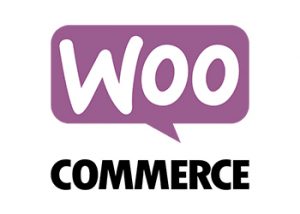
Launch Your Dropshipping Store with WooCommerce
Build your dropshipping store with WooCommerce, the #1 eCommerce plugin for WordPress. Free to start (you only pay for hosting), scalable with extensions, and perfect for selling physical or digital products directly from home.
Get Started with WooCommerce
Can You Make a Living Off Dropshipping?
Yes, absolutely! But it’s not a “get rich quick” deal. You can make a living with dropshipping if you treat it like a real business, not a weekend experiment. Did you know that, according to Dropshipping statistics, 27% of online retailers are now dropshipping?
It’s pretty easy to find inspiring dropshipping success stories online!
Many people start dropshipping on the side, then grow it into a full-time income as their marketing improves. The beauty of this model is that your costs scale with your sales. You’re not stuck with inventory or expensive overhead.
Still, your results depend on:
- Choosing the right products and niche
- Finding dependable suppliers
- Offering fast shipping and good customer service
- Consistently promoting your store
Think of it this way: learning how to set up a dropshipping business is the easy part – maintaining and scaling it is where the real work (and profit) happens.
If you want long-term success, reinvest in ads, SEO, and automation tools. That’s how you turn your store into a stable source of income – and yes, many full-time entrepreneurs are doing exactly that in 2025.

Launch Your Dropshipping Store with WooCommerce
Build your dropshipping store with WooCommerce, the #1 eCommerce plugin for WordPress. Free to start (you only pay for hosting), scalable with extensions, and perfect for selling physical or digital products directly from home.
Get Started with WooCommerce
How to Start Dropshipping
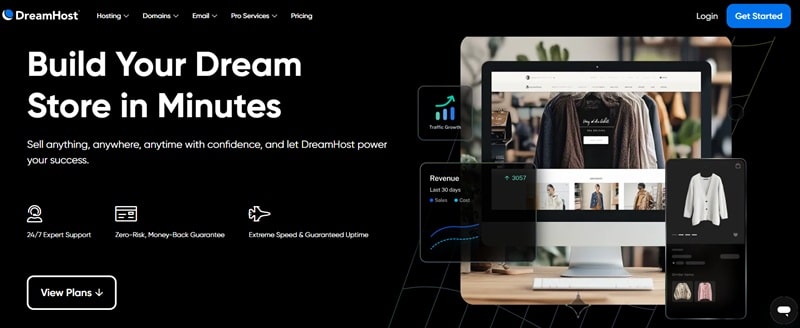
If you’re ready to take action but still wondering, “how do I start dropshipping?” – let’s simplify it. Think of this as your quick-start guide to how to set up a dropshipping business from scratch.
- Pick your niche: Use KWFinder to find product ideas that have search volume but low competition.
- Choose your platform: WordPress + WooCommerce is the most flexible and beginner-friendly setup (especially when hosted on DreamHost or SiteGround).
- Find your suppliers: Trusted sources include AliExpress, CJ Dropshipping, and SaleHoo.
- Build your store: Install WooCommerce, customize your theme (GeneratePress, Ashe PRO, or Divi), and add your products.
- Set up marketing: Focus on SEO, social media, and email marketing. Track your progress with MonsterInsights.
You don’t need a huge budget or a fancy office. Even if you’re looking for how to start dropshipping for free, you can start small – just make sure your store looks professional and loads quickly.
In short, the key to how to start a successful dropshipping business isn’t just launching – it’s refining. Test, improve, and stay consistent.
Now, let’s dive deeper into the step-by-step process of how to set up a successful dropshipping business in 2025 in the next section.
How to Set Up a Successful Dropshipping Business in 2025
Learning how to set up a successful dropshipping business in 2025 is about combining the right strategy, the right tools, and the right mindset. It’s no longer just about uploading a few products and hoping for sales – not anymore. Not now that there’s more competition.
In 2025, starting a solid dropshipping business is about building a brand that customers can trust and Google can rank.
Below, we’ll go step by step through everything you need to do – from choosing your niche and suppliers, to building your website and marketing it effectively.
Let’s get into it.
How to Find a Profitable Niche for Your Dropshipping Business
Finding the right niche is one of the most important steps when learning how to set up a successful dropshipping business. It’s not just about choosing a trending product – it’s about finding a balance between demand, profit potential, and long-term sustainability.
In other words, you need a niche that sells consistently, not one that burns out after a few viral months.
Beauty, health, personal, and household care niches are the most common sectors where dropshipping is used, according to Allied Market Research.
Start by thinking about evergreen products – those that stay in demand all year long. Categories like fitness accessories, kitchen tools, home office gear, pet supplies, or beauty items tend to perform well because people need them regardless of the season.
A profitable niche usually fits three criteria:
- It has enough product variety for upsells and bundles.
- It solves a problem or fulfills a strong desire.
- It’s not overly saturated.
When evaluating your dropshipping niche options, consider these key factors:
- Demand and trends: Use a keyword tool like KWFinder to research search volume and interest trends. You want keywords that show steady traffic, not sharp spikes. Look for long-tail terms like “best yoga accessories 2025” or “eco-friendly kitchen products”.
- Validate with data: Check Google Trends to ensure the interest is consistent, not just seasonal.
- Analyze competitors: Check Google, Amazon, and TikTok Shop to see what’s trending.
- Competition level: A bit of competition means the niche is profitable, but avoid markets dominated by big brands unless you can offer something unique.
- Base product cost: Choose products with a low-to-medium supplier price. If your base cost is too high, your profit margins shrink quickly once you factor in marketing and shipping.
- Audience clarity: You should know exactly who your customers are and what problems your product solves.
- Research suppliers: Browsing dropshipping suppliers’ catalogs will give you ideas and generate insights regarding base product prices.
Try to find a balance between passion and practicality. For example, if you love fitness, look for sub-niches like resistance bands or smart gym accessories. Remember, a profitable niche doesn’t have to be flashy – it just needs consistent demand, healthy margins, and room for you to stand out.
What Is The Easiest Niche for Dropshipping?
Choosing a niche can make or break your business. The easiest niches for dropshipping are usually ones with consistent demand, low competition, and simple shipping logistics.
Here are a few great beginner-friendly options for 2025:
- Pet products – low-cost, emotional buyers, easy to market.
- Fitness accessories – evergreen and trending.
- Home decor – light, easy to ship, and highly visual for social media.
- Beauty products – high repeat-purchase potential.
If you’re learning how to start dropshipping as a beginner, don’t just chase what’s trending at the moment. Pick something you genuinely enjoy, because you’ll spend time writing about it, promoting it, and building trust around it. The best choice is always a balance: something you enjoy, but that’s also in demand.
Use tools like KWFinder to analyze search demand and find low-competition keywords in your niche. This helps you optimize from the start and gives you a better chance of ranking high on Google, which is key if you want to set up a successful dropshipping business that lasts.
How to Start a Dropshipping Store (How to Set Up a Successful Dropshipping Business)
To truly build a successful dropshipping business in 2025, you need more than just an idea – you need the right foundation, the right setup: a branding domain name, a fast website, and a professional theme.
Fortunately, starting a dropshipping business website nowadays is easier than ever, especially with tools like WordPress, WooCommerce, and managed hosting services.
Below, I’ll guide you step by step through creating your store, choosing reliable WooCommerce hosting, installing the right plugins, and designing a store that actually converts.
What Is WooCommerce and How WordPress Hosting Works
WooCommerce is a powerful, free plugin that turns your WordPress website into a fully functional online store. It’s the backbone of thousands of eCommerce and dropshipping businesses around the world – and for a good reason: it’s flexible, SEO-friendly, and integrates with countless payment gateways and extensions.
But WooCommerce works best when hosted on WordPress-optimized hosting – the kind that’s built for great website speed, security, and reliability.
In dropshipping, every second counts. A slow website can cost you sales and rankings.
That’s why investing in WooCommerce hosting is crucial for your store’s long-term success.
Since WooCommerce is a free WordPress plugin, “WooCommerce pricing plans” actually refer to WordPress hosting.
The cheapest hosting plans, known as Shared Hosting (your website shares resources with several other websites), cost around $2-3 per month, but it’s too slow to make your dropshipping website competitive enough.
Managed Hosting (resources here are fully dedicated to your website) is the best choice for online stores, as it’s fast, secure, and built for businesses, costing around $16-19 per month.
WooCommerce with DreamHost (Managed Hosting): How to Set Up a Successful Dropshipping Business
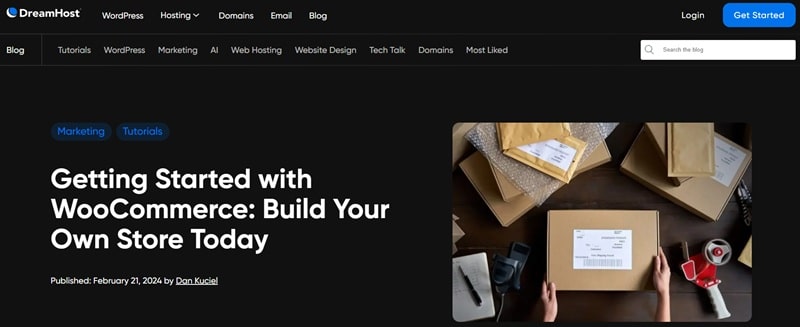
DreamHost offers a managed WooCommerce hosting plan that’s tailor-made for dropshipping and online stores. It includes pre-installed WooCommerce, automatic updates, and performance optimization out of the box.
Also, you won’t have to pay for backups, security, and technical maintenance services, as DreamHost’s managed WooCommerce hosting plan already includes all these features at no extra cost.
The standout feature? DreamHost’s AI Website Builder, which can help you create your WooCommerce dropshipping website in minutes – a game-changer for beginners who don’t want to handle the technical setup.
How to Sign Up for DreamHost WooCommerce Hosting
- Go to DreamHost WooCommerce Hosting.
- Choose the DreamPress WooCommerce plan.
- Complete your signup – DreamHost will automatically install WordPress and WooCommerce for you.
- Log in to your WordPress dashboard, and you’re ready to start customizing your dropshipping store.
DreamHost’s support team can also migrate your existing store or help you connect your domain, making the process super easy – even if you’ve never built a website before.
WooCommerce with SiteGround (Shared Hosting): How to Set Up a Successful Dropshipping Business
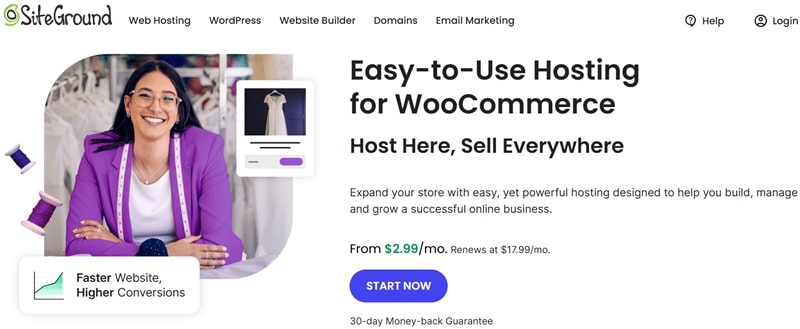
SiteGround is another top-rated option for WordPress and WooCommerce hosting. It’s known for its excellent uptime, fast site performance, and easy integration with dropshipping tools.
The platform automatically handles caching, SSL, and daily backups – all crucial for keeping your store secure and reliable. Plus, SiteGround’s interface is very beginner-friendly, so you’ll feel comfortable even if it’s your first eCommerce setup.
How to Sign Up for SiteGround WooCommerce Hosting
- Visit SiteGround WooCommerce Hosting.
- Choose a plan (the GrowBig or GoGeek options are great for scalability).
- Register your domain or connect an existing one.
- Once setup is complete, SiteGround automatically installs WordPress and WooCommerce for you.
Their customer support is also top-notch, ready to help you configure your WooCommerce dropshipping business from day one.
Can AI Build Me a Dropshipping Website?
Great question – and the short answer is yes. AI has changed the game for new entrepreneurs.
If you’re learning how to start a dropshipping business as a beginner and you’re not comfortable designing websites, DreamHost’s AI website builder, available on all WooCommerce plans, can do most of the heavy lifting for you.
Here’s how it works:
- You answer a few prompts about your niche and style preferences.
- The AI automatically creates a custom WooCommerce layout.
- You can then tweak it with drag-and-drop editing (no code needed).
It’s a lifesaver for beginners who want a clean, modern store without hiring a designer. And because it’s built within the DreamHost ecosystem, everything stays optimized for performance and SEO.
While AI won’t write your product descriptions perfectly, it can speed up your workflow dramatically.
For those following this path, I will always recommend reviewing all text for brand tone and accuracy – but yes, you can absolutely build a dropshipping website with AI in 2025 and have it look amazing.
Related: Easy Beginner-Friendly e-Commerce Platforms for Side Hustle in 2025
Choosing the Perfect Domain Name for Your Dropshipping Business: How to Set Up a Successful Dropshipping Business
Your domain name is your brand’s digital identity – it’s how people will remember and search for your dropshipping store. Think of it as your business card on the internet.
After you’ve chosen your niche, brainstorm a name that’s:
- short and memorable
- easy to spell
- relevant to what you sell
- avoid using hyphens or numbers
- always check that it’s not already trademarked.
When searching for a good domain name, you can use tools like DreamHost’s domain search. Most domains cost around $10–$20 per year, but here’s a great tip: DreamHost’s Managed WooCommerce Hosting includes a free domain name when you choose a yearly plan. Otherwise, if you’d like to pay for hosting monthly, you can purchase your domain separately (DreamHost always offers promotional prices for first-time buyers!)
But don’t worry if you’re still not sure about which name to choose – you can sign up for yearly hosting today and pick your free domain name later, once you’re confident in your niche and brand direction! 😉
Setting Up a Professional Email Address for Your Dropshipping Business
A professional email address (like hello@yourstore.com) instantly builds trust with your audience. It looks polished, reinforces your brand name, and makes your dropshipping business appear reliable.
On the other hand, replying to customers from a Gmail or Yahoo account can look unprofessional – and might even make some buyers hesitate to complete their purchase.
I mean, would you buy from a random shop that offers customer support to you from randomshop123@yahoo.com? Probably not, right?
Here’s the good news: DreamHost’s WooCommerce Hosting plan includes unlimited domain-based email accounts at no extra cost. This means you can create multiple emails for different purposes – for example, support@, sales@, or returns@yourstore.com – and manage them all easily from your dashboard.
So, no extra costs to look hyper-professional! 😁✌🏻
Having branded emails not only strengthens your credibility but also helps you maintain organized communication. It’s a small detail that makes a huge difference when you’re growing your dropshipping business and dealing with suppliers or customer service inquiries.
You may also like: 10 Best Affordable Email Service Providers for Small Business Owners
Post-Installation Steps (How to Set Up a Successful Dropshipping Business in 2025)
After signing up and installing WooCommerce, it’s time to polish your store and make it shine. These next steps ensure your website looks professional, runs smoothly, and is ready to attract customers.
The Importance of a Good WooCommerce Theme
Your WooCommerce theme is what your visitors see first – it sets the tone for your brand, affects user experience, and even impacts your Core Web Vitals.
A lightweight, SEO-optimized theme can improve your rankings and conversions, while a poorly coded one can drag everything down.
Let’s go through three excellent WordPress themes that work beautifully with WooCommerce and are ideal for a dropshipping business.
Divi Theme
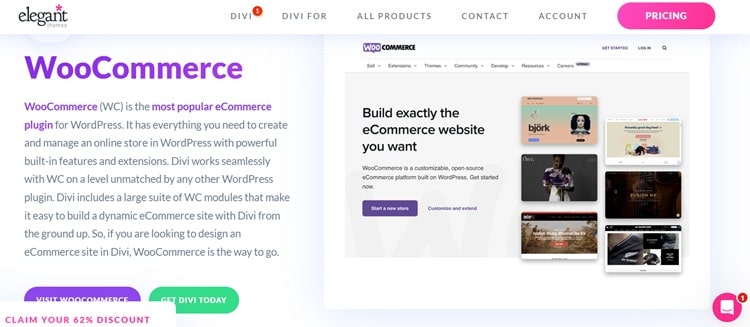
Divi is a visually stunning and highly customizable WordPress theme with a built-in drag-and-drop builder. For dropshipping, this means you can easily design unique product pages, landing pages, and checkout flows – no coding required.
It’s also mobile-optimized, integrates smoothly with WooCommerce, and has built-in marketing tools like split testing. If you want a store that looks premium and performs well, Divi is an excellent investment.
GeneratePress Theme
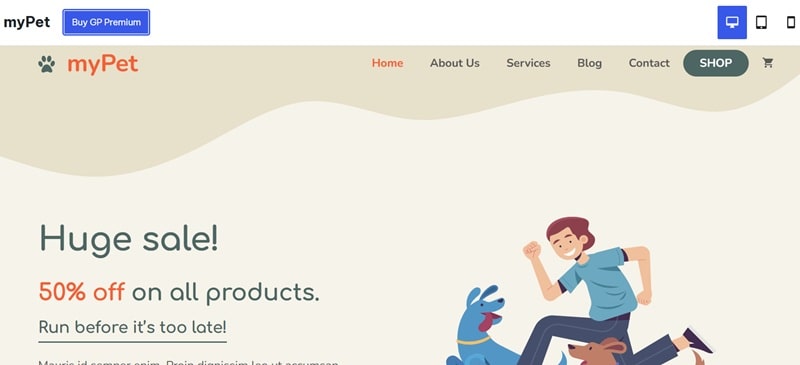
GeneratePress is lightweight, lightning-fast, and built with SEO in mind – exactly what you need when you’re starting a dropshipping business in 2025.
It’s easy to customize, works seamlessly with WooCommerce, and ensures your site loads fast on both desktop and mobile (a must for eCommerce). Plus, because it’s modular, you can activate only the features you need, keeping your store clean and efficient.
Ashe PRO Theme
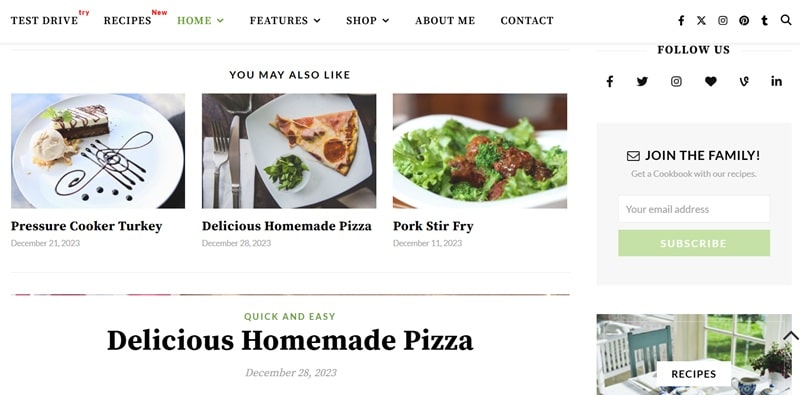
Ashe PRO is perfect if you want a minimalistic and modern store layout that still feels elegant. It’s responsive, supports WooCommerce beautifully, and gives you built-in blog layouts – perfect if you plan to grow traffic through content marketing.
It’s also optimized for speed and compatible with major page builders, making it an affordable yet powerful option for beginners in dropshipping.
Adding Must-Have Pages (How to Set Up a Successful Dropshipping Business in 2025)
Before launching, make sure your site has all the essential pages that build trust and comply with eCommerce regulations:
- About Page – shows transparency and builds brand credibility.
- Privacy Policy and Terms & Conditions – protect you legally.
- Returns & Exchanges Policy – assures customers they can shop with confidence.
- Shipping Information – clarifies delivery times and costs.
These pages also help your store appear more trustworthy to both customers and search engines, improving conversions and SEO.
How to Find Reliable Dropshipping Suppliers
Once you’ve chosen your niche, the next step in how to set up a successful dropshipping business is finding reliable suppliers. A good supplier is the backbone of your store – they determine your product quality, shipping speed, and ultimately your reputation with your customers.
When evaluating potential suppliers, look for consistency, transparency, and communication.
You’ll want someone who provides accurate product descriptions, offers reasonable shipping times, and responds quickly to inquiries. A slow or unreliable supplier can ruin even the best business plan.
Also, check platforms like Trustpilot to verify suppliers’ reputation!
Here’s what to look for in a trustworthy dropshipping supplier:
- Product quality and consistency: Order samples, whether it’s a dropshipping or POD supplier, to test items yourself before selling.
- Clear communication: Good suppliers reply promptly and are open about inventory, shipping, and returns.
- Reasonable shipping times: Especially if you’re targeting U.S. or European audiences – long delivery windows hurt conversions.
- Reputation: Check supplier reviews on independent platforms, read feedback from other store owners, and verify their business registration when possible.
- Flexibility: Working with multiple suppliers can help you expand your catalog and prevent stock issues – just ensure your product descriptions and branding stay consistent across all items.
Pro tip: Add supplier diversity early – that way, if one has stock issues, you won’t lose sales. It’s also smart to mention in your About page that you “work with international suppliers”, so customers understand shipping times. That will save you from many angry customers!
Finding reliable partners might take some time, but it’s worth the effort. Let’s look at ten of the most trusted and beginner-friendly dropshipping suppliers to consider in 2025.
10 Reliable Dropshipping Suppliers for 2025 (How to Set Up a Successful Dropshipping Business)
1. AliExpress
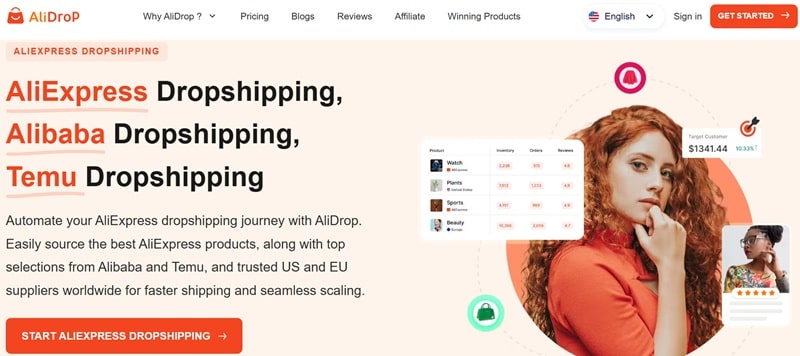
A classic choice for beginners, AliExpress Dropshipping offers millions of products across virtually every category. Many sellers offer ePacket or faster shipping options, making it ideal for testing new products without large upfront costs.
2. Spocket
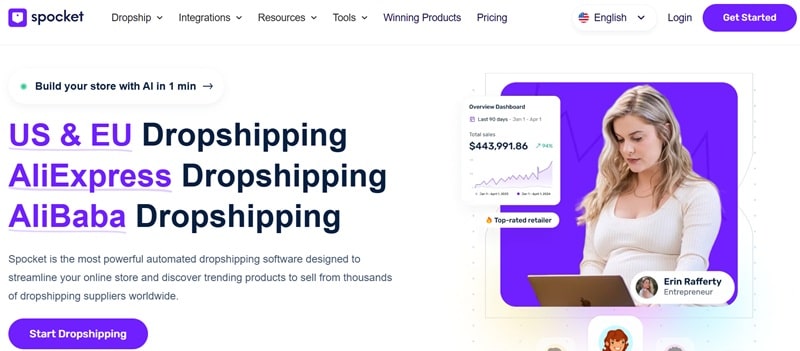
Spocket connects you with suppliers primarily based in the U.S. and Europe, allowing for faster delivery and higher-quality goods. It integrates directly with WooCommerce and Shopify, making management simple.
3. SaleHoo
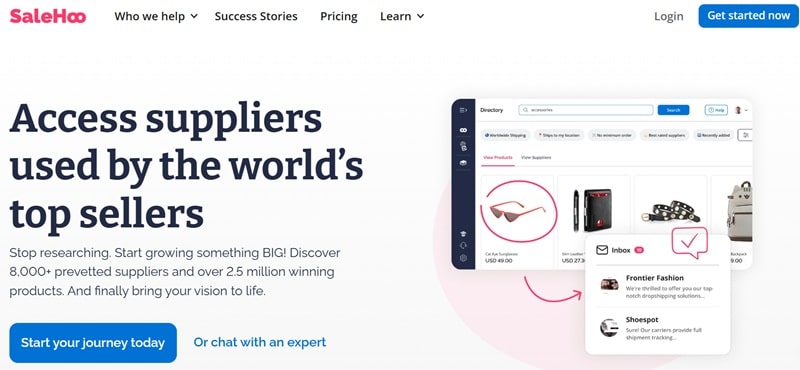
SaleHoo is a vetted supplier directory with over 8,000 trusted wholesalers and dropshippers. It’s ideal if you want peace of mind – every supplier is verified before being listed.
4. CJdropshipping
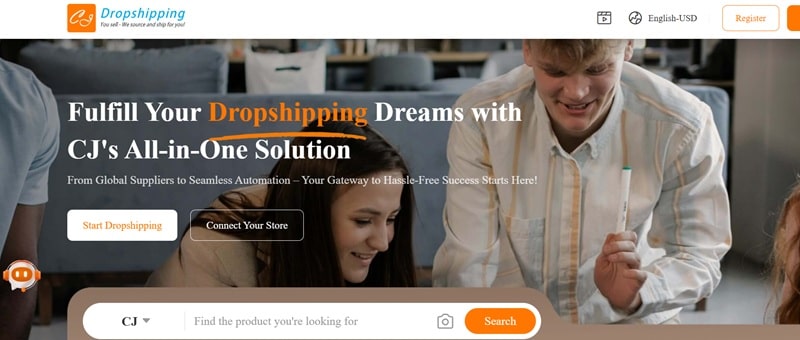
CJdropshipping offers global warehouses and an all-in-one dashboard to manage products, orders, and fulfillment. They also provide product photos and branding options, which can elevate your store’s look.
5. Modalyst
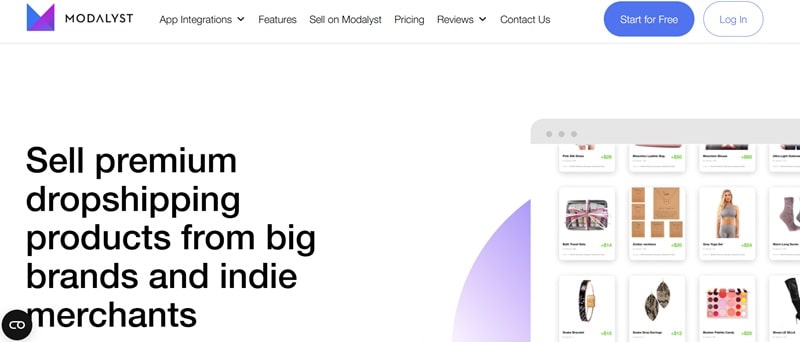
Modalyst focuses on branded, high-quality products, including eco-friendly and sustainable items. It integrates easily with WooCommerce and supports automatic order fulfillment.
6. Printful
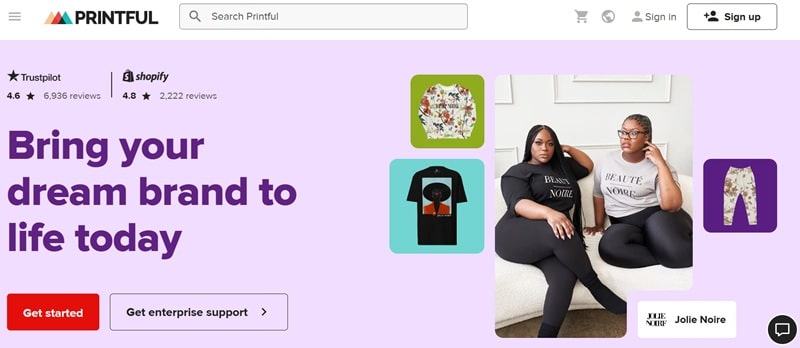
Perfect for custom designs, Printful handles print-on-demand products such as t-shirts, mugs, and tote bags. Print-on-demand drop shipping is great if you want to sell personalized or branded merchandise alongside standard dropshipping products.
7. Doba
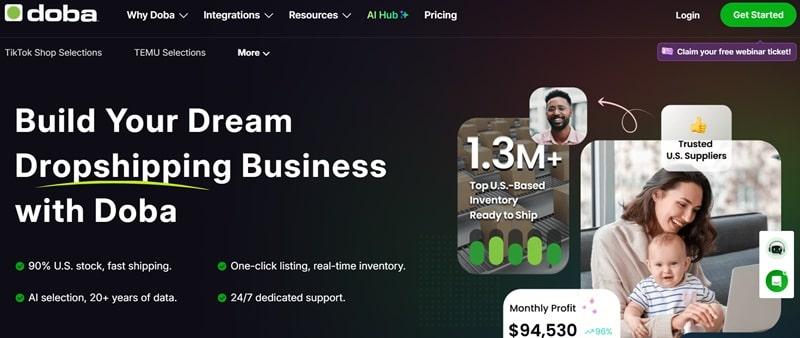
Doba acts as a supplier aggregator – you can source from multiple suppliers within one platform. It’s ideal for managing inventory across different niches while keeping operations organized.
8. Worldwide Brands

This directory has been around for decades and lists thousands of certified wholesalers and dropshippers. Worldwide Brands is perfect for business owners who value long-term reliability over trendy shortcuts.
9. Syncee
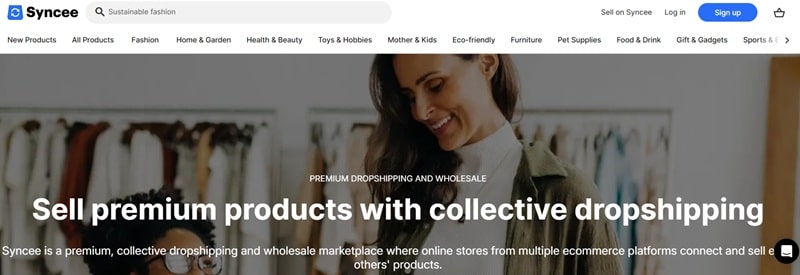
Syncee offers a large global supplier network and focuses on automated inventory syncing and order processing. It’s a great choice if you want to manage multiple suppliers under one account.
10. GreenDropShip
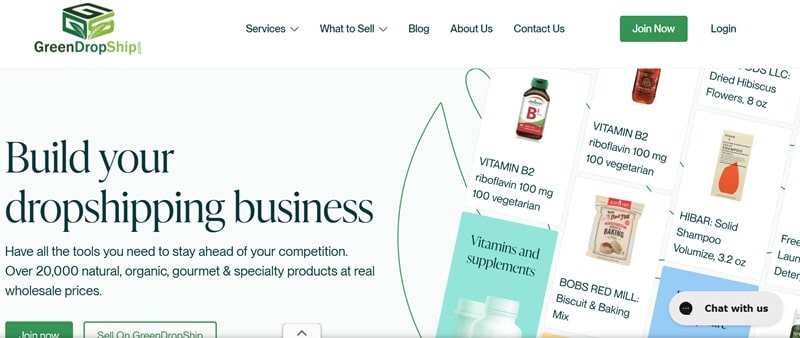
If you want to target eco-conscious buyers, GreenDropShip specializes in natural, organic, and eco-friendly products. They stock U.S.-based inventory for faster shipping and better quality control.
Marketing Your Dropshipping Business: How to Set Up a Successful Dropshipping Business
You’ve built your store – now it’s time to get eyes on it. Marketing is where your business either grows or fades into the background.
When people ask “how to set up a successful dropshipping business”, they often underestimate how crucial marketing is. The good news? You don’t need a big budget to start – just strategy and consistency.
Here’s what to focus on:
1. SEO (Search Engine Optimization)
SEO is one of the most powerful long-term strategies to attract consistent, free traffic to your dropshipping store. Every product page, blog post, and category should target relevant keywords – for example, if your niche is pet supplies, you could optimize for terms like “best dog grooming tools” or “eco-friendly cat toys”.
Use reliable SEO WordPress plugins like AIOSEO to optimize titles, meta descriptions, and schema markup. These tools guide you step by step so your content ranks better on Google and looks professional in search results.
To build topical authority, create long-form blog content related to your niche – tutorials, buying guides, and comparison posts. For instance, if you sell pet products, you could write: “How to Groom Your Dog at Home — The Tools You Actually Need”. Each post strengthens your site’s authority and sends valuable traffic to your product pages.
And since DreamHost’s Managed WooCommerce hosting includes built-in WordPress blogging features at no extra cost, you can grow both your store and blog under one platform seamlessly.
2. Social Media Marketing
Social media is your stage to show off your products in action. Platforms like TikTok, Instagram, and Pinterest are visual goldmines for dropshipping – especially for lifestyle or pet niches. Short demo videos, funny reels, or “unboxing” clips can quickly go viral and drive free traffic to your store.
If you’re selling pet accessories, share clips of adorable dogs using your products or post “before and after” grooming transformations. On Pinterest, create boards featuring your products in everyday use with strong keywords in the pin descriptions – this helps with social SEO, too.
Consistency is key: post regularly, engage with comments, and test different content formats until you discover what resonates best with your audience.
3. Email Marketing

Your email list is one of your most valuable business assets. Collect emails through discount popups, lead magnets, or freebies (“Sign up for 10% off your first order” works great). Then nurture that audience with consistent, friendly updates – weekly newsletters, new arrivals, product tips, or seasonal sales.
Tools like MailerLite or Brevo make this super easy to automate. You can even segment your audience – for example, send one email to dog owners and another to cat owners if you’re in the pet niche. This personalization makes a big difference in engagement and sales.
4. Analytics and Tracking
If you’re serious about growing your dropshipping business, you need to know what’s working – and what’s not. MonsterInsights integrates Google Analytics seamlessly with WordPress and WooCommerce to show you key data: where your visitors come from, which pages they love most, and what products drive conversions.
You’ll also see your bounce rate and traffic sources, which help you fine-tune your SEO and content strategy. For example, if your “best dog leashes” page gets the most views but few purchases, that’s a sign to improve your product descriptions or images.
Data-driven decisions will keep your growth steady and sustainable – no guessing games needed.
5. YouTube and Video Marketing
Don’t underestimate the power of YouTube marketing. It’s the second-largest search engine in the world – and perfect for visual niches like dropshipping. Create product demo videos, unboxings, or tutorials (“How to Choose the Right Dog Harness” would be perfect for a pet niche).
Apply YouTube SEO best practices by optimizing your video titles, descriptions, and tags with relevant keywords. Link directly to your product pages and blog posts in the video descriptions. Over time, your videos can rank on both YouTube and Google, sending steady traffic to your store.
This also ties beautifully with your blog strategy – embed your videos into related blog posts to increase on-page time and engagement (a big plus for SEO).
6. Paid Ads (Optional)
Once you start seeing consistent traffic and conversions from organic methods, you can scale up with paid ads. Platforms like Facebook Ads and Google Shopping are great for testing new products and boosting visibility.
Start small – set a daily budget you’re comfortable with and monitor results closely. Use retargeting ads to re-engage visitors who didn’t buy the first time; they’re often your easiest future customers.
With the right data from your analytics, you can refine campaigns over time and steadily grow your return on ad spend.
Remember: the more consistent your content and branding, the more trust you build – and trust is what drives repeat customers.
Building a Memorable Brand Identity: How to Set Up a Successful Dropshipping Business
Branding is more than just a logo – it’s the emotion your store conveys. From your store name and color palette to the tone of your product descriptions, everything should reflect your niche and connect with your audience.
A consistent, trustworthy brand helps shoppers remember you and feel confident buying from you again. Think of your brand as your store’s personality – make it clear, relatable, and authentic across your website, social media, and emails.
Setting Up Clear Shipping & Returns Policies
Your shipping and return policies are key to building trust. Be upfront about delivery times, fees, and how customers can return or exchange products. A clear, fair policy reduces hesitation and increases conversions – especially for first-time buyers. If you offer worldwide shipping, mention the regions covered.
And don’t overlook a professional “Returns & Exchanges” page – it gives your store a more established and reliable look, which customers value highly.
Smart Pricing Strategies for Profit & Loyalty: How to Set Up a Successful Dropshipping Business
Your pricing strategy should balance profit and customer satisfaction. Offer free shipping for orders above a certain amount to encourage bigger purchases – just make sure to factor in shipping costs. Use discount codes strategically to reward repeat customers and boost loyalty.
Also, remember to account for payment gateway fees so you’re not cutting into your profits. A smart mix of competitive pricing, transparency, and incentives keeps customers coming back again and again.
Setting Up Payments and Taxes for Your WooCommerce Store
One of the most important steps in creating a successful dropshipping store is setting up your payment gateways and taxes correctly. Your store can look amazing and have great products, but without smooth payment options, customers will simply leave. WooCommerce makes this part easy – it integrates with popular gateways like PayPal, Stripe, and WooPayments, which allow you to accept credit cards, debit cards, and even local payment options securely.
Make sure your payment methods are reliable, fast, and familiar to your audience. The checkout process should be simple and trustworthy – this is where visitors decide whether they’ll actually buy. You can also enable Apple Pay or Google Pay for extra convenience on mobile devices.
Taxes depend on your business location and where you ship products. WooCommerce can automatically calculate sales tax based on your customers’ region using built-in geolocation tools. It’s important to check your local tax regulations and consult an accountant if needed to stay compliant.
A few quick tips to get this step right:
- Always test your checkout process before launching.
- Display all costs upfront to avoid abandoned carts.
- Automate tax collection whenever possible.
Setting up payments and taxes the right way from the start helps you avoid costly issues later – and keeps your customers’ trust intact.
Scaling and Optimizing Your Dropshipping Business
Once your store starts making consistent sales, your next goal is optimization and automation.
To truly set up a successful dropshipping business, you’ll want to refine every step of your process:
- Automate orders with plugins like WooDropship or Ali2Woo.
- Outsource tasks like content writing, product imports, or customer support.
- Expand your product line strategically – don’t overwhelm your store, but add related items for upsells.
- Improve speed and UX by using lightweight themes and caching tools (both DreamHost and SiteGround handle this beautifully).
Then, start creating content-driven marketing funnels: blog posts that link to your products, lead magnets that collect emails, and social media content that points back to your store.
Keep an eye on your numbers with MonsterInsights and always test: new layouts, pricing strategies, and product descriptions.
Remember, even the most profitable stores evolve – and 2025’s dropshipping winners are the ones who adapt fast.
What Are the Biggest Mistakes Dropshippers Make?
Many new dropshippers jump in too fast without planning – and that’s where problems start. The most common mistakes include choosing a niche just because it’s “trending”, partnering with unreliable suppliers, or setting prices too low to make a profit.
Others ignore SEO and rely only on ads, which burns money quickly.
Skipping customer service, unclear shipping policies, and using generic product descriptions also hurt trust and conversions.
The key is to treat dropshipping like a real business – focus on branding, quality suppliers, and long-term customer relationships.
How Much Do I Need To Start Dropshipping?
Let’s be honest – one of the biggest reasons people look into how to start dropshipping is that it seems relatively inexpensive to begin with. And it can be, especially when you compare it to traditional retail. Still, you’ll want to budget for some essentials.
Here’s a quick breakdown of what you’ll typically need to invest to set up a successful dropshipping business:
- Domain name: around $10–20 per year (get yours for free with a yearly hosting plan!)
- WooCommerce Hosting plan: $15–30 per month (WooCommerce hosting with SiteGround or DreamHost)
- Theme + plugins: $40–100 (one-time or yearly)
- Marketing tools (optional at the beginning): around $10–50 per month (email tools, analytics, etc.)
Even if you’re learning how to start dropshipping for free, you’ll still need at least hosting and a domain.
Realistically, you can start dropshipping with about $75–$200, which is a small investment to launch your own business in 2025.
Final Thoughts on How to Set Up a Successful Dropshipping Business
Dropshipping is still one of the most accessible online business models in 2025 – but success depends on execution.
Today you’ve learned:
- How to start a dropshipping store step-by-step.
- How to choose profitable niches and suppliers.
- How to leverage AI, hosting, and SEO tools.
- How to build and scale your brand.
Now it’s your turn to put it all together. Whether you start with DreamHost WooCommerce (for simplicity) or choose SiteGround WooCommerce (for more control), remember – consistency beats perfection.
Set goals, track data, and refine as you go. That’s how real e-commerce success happens.
And before you know it, your store could be the next great case study in “how to start a dropshipping business that actually works”!


